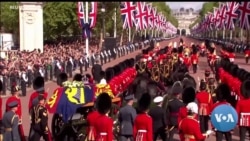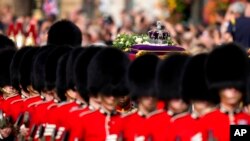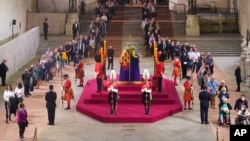Tens of thousands of people have lined up to view the coffin of Britain’s late Queen Elizabeth II as she lies in state in Westminster Hall ahead of her funeral next week.
Her body was taken in a solemn procession from Buckingham Palace, where it had remained overnight after being transported to England from Scotland, to Westminster. The coffin, adorned with the imperial state crown and the royal standard, was carried by the same horse-drawn gun carriage that had borne the bodies of her mother and father.
King Charles III walked behind the coffin, joined by his sons, William and Harry, and his siblings, Anne, Andrew and Edward.
Tens of thousands of people watched from the roadside to catch a final glimpse of the monarch, offer a last goodbye and witness firsthand an extraordinary piece of history unfolding. Most watched in silence. Some threw flowers. Some quietly wept.
U.S. citizen Silver Klajnscek, who lives in London, spoke to VOA after the procession passed.
“There’s such a respect for — I don’t know a better way to put it, but pomp and circumstance in this country — that really pulls people together. And it’s really an honor to be a part of it,” she said.
Gun salutes echoed across the capital. In London’s Hyde Park, thousands more people watched the procession on big screens.
Under late summer sunshine, the procession arrived in Westminster 38 minutes after leaving Buckingham Palace. It is a journey the queen had made so many times before, across seven decades on the British throne stretching back to the government of Winston Churchill.
Her coffin was carried into Westminster Hall by guardsmen from the 1st Battalion Coldstream Guards, who had been flown back from Iraq for the occasion. The queen was their company commander.
At Westminster Hall, Archbishop of Canterbury Justin Welby and Dean of Westminster David Hoyle read prayers at the service. Those in attendance for the historic event included Catherine, Princess of Wales, Meghan, Duchess of Sussex and Camilla, Queen Consort.
At the end of the brief service, the queen’s body officially lay in state — and the doors of the great hall opened for the public to mourn their monarch.
Outside, lines of people several kilometers long had formed. They could face a wait of up to 27 hours to reach Westminster Hall.
“I haven't had any sleep whatsoever. I'm just going with the energy that's within. I feel very uplifted, very calm and happy. Happy to be able to show my last respects to the queen,” 61-year-old Stephen Holdgate said.
“She’s been there my entire life. She’s like a grandmother,” London resident Neil Martin told VOA.
Nearby, Bryony Stevenson waited in line with her 3-month-old baby.
“It’s one of those once-in-a-lifetime occasions,” Stevenson said. “My little one was born a Jubilee baby, and it’s important for us to make this occasion, because it’s a huge part of history.”
Westminster Hall was built in 1097. It hosted King Henry VIII’s coronation banquet in 1509; the trial of Guy Fawkes in 1606, who plotted to blow up parliament; and the trial of King Charles I in 1649 following the English Civil War. For the next four days, the hall is playing no less a historic role in this ancient kingdom.
Elizabeth died Sept. 8 at Balmoral Castle in the Scottish Highlands, a place she cherished and where Charles became king.
The queen’s funeral is scheduled for Monday at Westminster Abbey, with numerous world leaders expected to attend. The coffin will then be taken to Windsor for the committal service, where the queen’s husband, Prince Philip, was laid to rest in April 2021.
Some information in this report came from The Associated Press, Reuters and Agence France-Presse.












